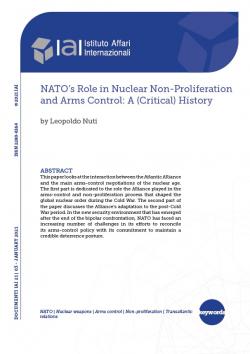NATO's Role in Nuclear Non-Proliferation and Arms Control: A (Critical) History
This paper looks at the interaction between the Atlantic Alliance and the main arms-control negotiations of the nuclear age. The first part is dedicated to the role the Alliance played in the arms-control and non-proliferation process that shaped the global nuclear order during the Cold War. The second part of the paper discusses the Alliance’s adaptation to the post-Cold War period. In the new security environment that has emerged after the end of the bipolar confrontation, NATO has faced an increasing number of challenges in its efforts to reconcile its arms-control policy with its commitment to maintain a credible deterrence posture.
-
Details
Rome, IAI, January 2021, 40 p. -
In:
-
Issue
21|03
Introduction
1. NATO, nuclear deterrence and arms control: the history of a difficult relationship
1.1 The origins of NATO’s reliance on nuclear deterrence
1.2 NATO transformed – the early steps towards détente
1.3 NATO and the “golden age” of arms control
2. The post-Cold War era
2.1 The crucial period, 1989-1992
2.1.1 Introduction
2.1.2 Adapting NATO’s strategy
2.2 The transformation of the Alliance in the post-Cold War era
2.2.1 Into the 1990s
2.2.2 The last great nuclear debate, 2008-2012
Conclusions



